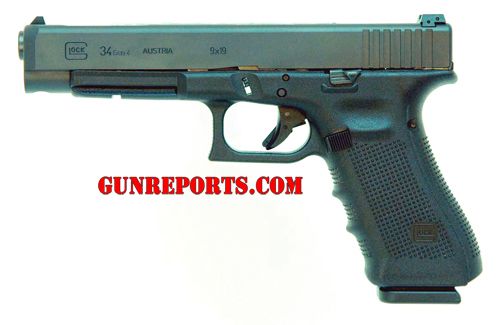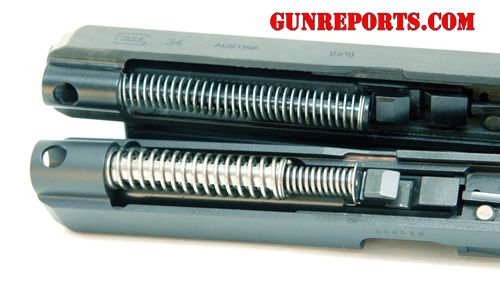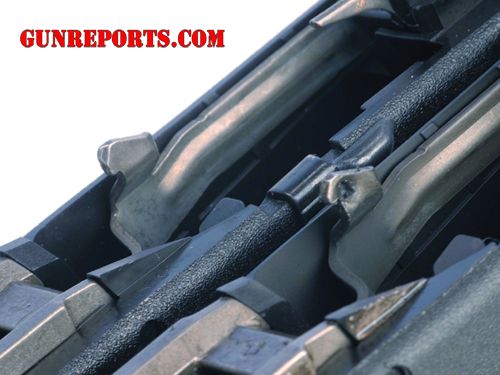Gun Tests Magazine recently tested five high-capacity semi-automatic 9mm handguns that were aimed at the Practical Shooting competitor. Practical Shooting evolved from experimentation with handguns used for self-defense. One characteristic that separates Practical Shooting from other organized pistol competition is that the scoring takes into account the amount of time it takes to deliver the required number of shots for each course of fire. So, fast-action gun handling, as well as quick, precise shots becomes an integral part of the shooter’s score. In another test, they paid particular attention to features and components that make the guns faster and easier to operate, as well as more accurate. They chose to look at the Glock G34 Gen 4 9mm. Here’s what they said:
Our earlier roster included two guns that were specifically prepared for competition by CZCustom of Mesa, Arizona. In this test, the gun was not as specialized. To date, most Glock shooters use the Gen 3 version of the G34 as tested previously. In this test we’ll try using the new $649 G34 Gen 4 pistol to see what effect the Gen 4 features may have in making it a better choice for competition.
Each pistol was tested for accuracy from the 25-yard line by firing from a sandbag rest. Test ammunition was the same as used in our previous test, including new manufacture (red box) 115-grain FMJ, and 124-grain JHP rounds from Black Hills Ammunition. We also fired 147-grain flatpoint FMJ rounds from Federal American Eagle. One of our guns offered a single-action trigger, so we took advantage of this option and shot groups of record with the HK P30L single action only.
To learn more about the match potential of the pistol we set up two action tests. Our “field” course of fire was the same one used previously, consisting of picking the gun off a table top and firing at two IPSC Metric targets 21 feet downrange spread 15 feet apart. The shooter was centered between the two targets and the catch was that the gun was fully empty with pistol and loaded magazine lying next to each other. The shooter began with hands placed flat to either side of the gun and magazine. Upon an audible start signal from our CED8000 shot recording timer, our shooter loaded the gun, and moving from left side target to right side target, fired two shots to the center mass A-zone (a 5.9-inch-wide by 11.2-inch-tall rectangle). The shooter then reengaged from left to right but this time with only one shot to the head areas which measured about 6-inches square. Inside the head area was a 4×2-inch rectangular A-zone surrounded by B-zone values. We also carried over our “double-tap” test but with different rules. We still wanted to know how fast we could deliver a quick pair of shots, but we also wanted to know how fast the guns could be reloaded in situations where the chamber was not yet empty nor the slide locked back. The target for this test was Caldwell’s plastic-coated 8-inch Bullseye TipTop targets which overall measured 8.5×11 inches and were punched for loose-leaf storage. Figures from our double-tap test reflected the elapsed time between the first and second shot after we had raised the gun from about a 45-degree angle from the horizon. And the amount of time it took us to reload, acquire the sights and fire, then the elapsed time between the final two shots.

In addition to judging match potential, we also wanted to know how the gun would relate to non-competitive or beginning shooters. The good people at F.O.R.T. Texas training helped facilitate this test, and we asked them why our test gun might or might not be included in their “dirty dozen,” a house collection of 12 different handguns that students are welcome to try to learn firsthand what type of pistol might fit them best. Here’s what we found.
Glock G34 Gen 4 9mm $649
In the Gen 4 pistols, the manufacturer has chosen a mild grid of small pyramids with the tops flattened to enhance its non-skid properties. This was after several runs of grip frames with full pointed spikes were offered to law-enforcement personnel. For those who typically wore gloves on the job, the sharper knobs were fine. But body contact while holstered did present a problem. We found that the blunted spikes were a real improvement over the texture on our Gen 3 pistol and did not make concealed carry uncomfortable nor did the gun grab on to fabric.
One of the frame variations that Glock has tried is the short-trigger-reach frame, or SF for “short frame.” But, rather than produce two different models of short and standard size frames the Gen 4 pistols now come with two alternate panels that attach to the backstrap. Without either panel in place, the G34 Gen 4 is essentially an SF pistol.

The extra panels slide on to the frame via two contour lines that, when exposed, appear perfectly natural to the eye. At the top of the backstrap beneath the web of the hand sits a pin inside a relief. This is actually a place keeper, which is replaced by a larger pin necessary to hold the alternate panels in place. The two panels are marked M for medium and L for large. They didn’t change the angle or contour of the back strap so much as they added distance to the trigger.
The magazine release on the G34 Gen 4 differed from our G34 Gen 3 by not having the same-style oversized magazine release. It didn’t protrude as much from the side of the frame, but was longer front to back. However, the Gen 4 magazine-release button can be changed to the other side of the pistol, making the gun more appealing to left-handed shooters. There were magazine catch lugs on both sides of the body of our three supplied Gen 4 magazines.
Internally there were two more changes from the Gen 3 pistol. Whereas the Gen 3 operated with single flat-wire spring captured over a polymer guide rod, the Gen 4 system consisted of three round wire springs over two reciprocating rods. There was a short, closely wound spring to the rear and a small-diameter spring hugging the forward part of the guide rod encased in a tube. The forward section was completely surrounded by a larger recoil spring. The other internal modification was referred to as a dot disconnector by a Glock representative we spoke to on the phone. Indeed, at the tip of the disconnector, the surface is punctuated with a dot not much different than if you were to make an indentation with a hammer and punch.
At the range found that we liked the G34 Gen 4 best without any of the alternate backstraps in place. We could feel the frame contour pushing the web of our strong-side hand comfortably as high as it could go into the beavertail beneath the top end. This should eliminate the cost of grip reduction for all but the most picky competitors. We sort of missed the big oversized magazine release and thought we might be losing some speed as our thumbs searched for the magazine release. But the SF grip reduction did give us a head start in reaching the release button by reducing what many consider to be the most important circumference found on the grip of a pistol. That is the line formed by the middle finger as it curls beneath the trigger guard and meets the thumb. How much more help the shooter needs to quickly access the release button is a matter of individual ergonomics.
When we first got our Gen 4, we oiled the gun but not the guide rod. The first few rounds of light 115-grain FMJ rounds failed to completely cycle the slide. We dropped the magazine, cleared the chamber, recessed the slide about one-quarter inch, pulled down on the release lugs and stripped the slide from the frame. The recoil unit was easy to take out and install, but we made sure to lubricate it with moderately light BreakFree oil, beneath the small rear spring, inside the support tube, and the outer surface of the support tube. After lubrication was performed, there were no malfunctions of any kind. Shot total for the session was approximately 400 rounds.

We thought the action of the recoil assembly was very consistent. But shooters who prefer to tune their guns to the strength of dedicated match ammunition may have to wait for the aftermarket specialists to develop a guide rod for Gen 4 pistols wherein the strength of the recoil assembly can be adjusted.
From the bench, our G34 Gen 4 shot the best overall groups of the test loaded with 115-grain FMJ rounds from Black Hills Ammunition. Average group size was 2.1 inches center to center for both the 124-grain and 147-grain ammunition. But the Glock was the only pistol in the test to produce sub-2 inch groups with each choice of test ammunition. This performance was comparable to results from our earlier test of the G34 Gen 3.
In the double-tap test we were pretty much hammering the trigger, even though a 10-yard target is not exactly the broad side of a barn. It was during our field test that we began to appreciate the little dot in the disconnector. With our hands locked into the grip, we were able to concentrate more fully on trigger press as we slid the sights into position. Indeed, we were wondering why our Gen 4 felt more consistent. Whereas our G34 Gen 3 pistol with 3.5-pound connector produced a trigger pull that we measured at about 4.5 pounds of resistance, our Gen 4 model arrived with a heavier connector, producing a trigger pull weight of about 6.5 pounds. There is always talk of trigger jobs that lighten the resistance of a trigger, but we found that the Gen 4 trigger was utterly predictable and consistent in its take-up, break, and reset. We think this not only made the gun faster and more accurate at speed but safer to handle as well.
Over the course of ten runs of our double tap/reload/double-tap test, we were able to drop from an elapsed or split time of .38 seconds for the first pair, a 2.14-second reload and a .37-second pair to a score of .26 seconds, 1.88 seconds, and .27 seconds, respectively. Our final runs (numbers 7 through 10) were within a few hundredth seconds of this score. Best overall split time was .25 seconds and our fastest reload took 1.71 seconds.
In the field test, picking up the gun, loading, and firing an accurate first shot took 2.48 to 2.88 seconds. Overall elapsed time ranged from 5.88 seconds to 6.33 seconds. The middle of the two targets showed 15 A-zone hits, and 5 C-zone hits. The head areas showed a combined total of 3 A-zone hits and 7 B-zone hits.
Our Team Said: What we gave up in the lighter trigger of the Gen 3 pistol we think we got back in control of the Gen 4. The grip frame provided greater stability, in our view, and felt recoil seemed more consistent, too. Together, this helped us dedicate more concentration to sight picture and trigger control. Non-competitive shooters might prefer the added sight radius of the G34’s longer top end, but its sister gun, the service length G17 Gen 4, would be a more practical choice for everyday use.



























